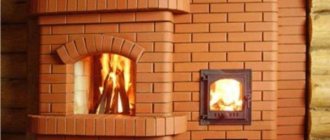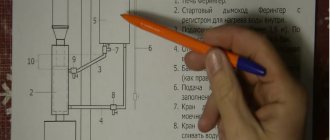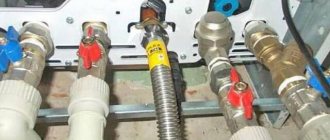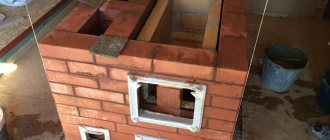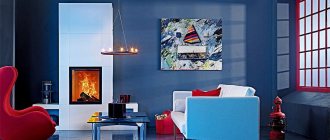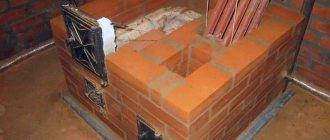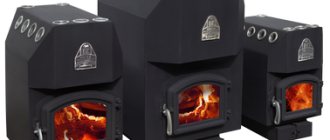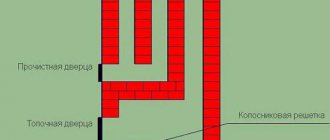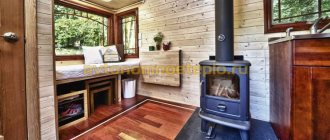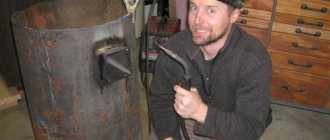When solving the issue of heating for a summer house, you can find many options on the modern market.
Finnish wood stove for a summer residence
And, despite the fact that new technologies are improving more and more every year, many still prefer the good old wood-burning stoves.
Today it is not just a heating device, but also a special decorative element that allows you to give the overall style of the house a certain “zest” and authenticity.
Among the huge selection of heating appliances presented on the domestic market, Finnish stoves occupy a significant share.
A Finnish stove for a summer cottage is a reasonable, compact and effective solution that allows you to quickly warm up a room and maintain the required temperature for a long time. What is the peculiarity of the design, and what characteristics should you choose a Finnish stove for your dacha - we will talk in this article.
Features of this equipment in the house
Solid fuel stove with stove
- Operating principle. It is based on continuous combustion. Internal systems have been modernized. The combustion chamber is characterized by a large volume. Injection elements are concentrated inside it. Through them there is a supply of air for afterburning of the eliminated gases. Finnish companies are among the pioneers in the use of the pyrolysis process to develop heat output and combustion period. The design has an afterburning sector. When burning and maintaining high temperatures, and blocking oxygen, solid fuel forms carbon dioxide. He goes to a special department. There it is burned, and additional volumes of thermal energy are generated.
- Methods for the movement of gases from smoke. The escaping heated gases do not leave the furnace immediately, but first direct heat to the liquid heat carrier. Heat from them can also be transferred by air. Thermal energy is accumulated much better. Thanks to this, efficiency increases by 5-10%.
- Heating of premises. This is carried out by convection tunnels or an integrated heat exchanger.
- Functional potential. Modern wood-burning models often include a cooking surface. There is also an option to connect air ducts to heat adjacent rooms.
Finnish home stoves are also quite economical. During their work, they absorb 15-30% less fuel than their various counterparts. Their efficiency reaches 92%. They also have a long service life.
Choosing a solid fuel stove from Finland
If you decide to purchase a Finnish stove, then remember that experts recommend paying attention to the following equipment parameters:
- Furnace functionality. Manufacturing companies offer their customers a variety of models of these heating devices, so you can choose a stove with a hob for cooking or an oven. There is enough power for cooking and heating water.
- The metal from which the body is made. The material can be steel and refractory cast iron.
- Convection and water-heating wood-burning stoves made of metal are characterized by low weight, fast heating and heating of rooms, ease of installation and connection to an existing heating system.
- Finnish cast iron stoves for the home are expensive devices (a couple of times higher than the cost of analogues). They have a long service life (minimum 30 years), good thermal capacity and considerable weight.
- Type of fuel. Stoves will have the best heat output when burning wood or pellet pellets. However, the technical documentation states that the stoves can operate on different fuels made from wood derivatives. Coal cannot be used. To extend the burning time of a single filling, it is recommended to place wood briquettes in the stove.
Stoves from Finland with a cooking function can consistently serve the owner for about 25 years. The construction material does not fade and does not react to contact with acids. Cast iron does not lose its appearance over time and is not difficult to maintain.
NunnaUuni stove-stove made of soapstone
Long burning versions
The specifics of these modifications are as follows:
- Positions of convective channels. They allow optimal accumulation of heat from the combustion chamber. Cold air ends up inside the housing, passing through special outlets at the bottom of the device. The air masses are rapidly warming up. And warm air fills the room within 2-5 minutes from the start of the kindling.
- Heating of adjacent rooms. Long-burning wood-burning air-heating modifications can be used as a heating base for an entire house. With prolonged combustion, warming up a building with an area of no more than 350 - 400 sq.m is enough. The connection of air ducts is possible due to the design of the housing. Pipes are distributed throughout the building. Each pipe ends up in every room that needs heating.
Some modifications have a compartment in the body where you can store the required amount of firewood. With it, the stove can work for several days.
Purpose
The stove can perform different functions depending on the type of room in which they are installed.
Wood-burning Finnish sauna stove
Sauna stoves
In such steam rooms, the stove must be able to heat the air in a short period. This does not produce steam. The sauna maintains a high temperature exceeding 100 degrees (sometimes it even reaches 140...150 degrees). At this temperature, the air in the room is very dry. Its humidity is in the range of 5...15%. It is the combination of high temperatures and low humidity that allows the human body to easily tolerate such conditions and benefit from it.
Sauna stove
In saunas you can hardly find massive stoves with the heart hidden from view - the stones. Today, as a rule, they are equipped with electrical structures with an open compartment in which stones are buried.
The main purpose of a sauna stove is to quickly heat the room to the desired temperature and maintain it for a long time. But you won’t be able to see how the flames embrace the stones or smell the aroma of burning wood.
The oven should quickly heat the room to the desired temperature
Important! Exposure to dry air can be negative. The upper respiratory tract and mucous membranes are especially affected.
Bath stoves
The bathhouse creates completely different conditions. It maintains a temperature no higher than 90 degrees. You should not raise it higher, otherwise it will become impossible to stay in the steam room. At the same time, air humidity is approximately 60%. This mode is not suitable for many, so the temperature drops to 60 degrees and the humidity level to 40...50%. The thermal conductivity of such air masses is much higher, which ensures deeper heating.
Bath stove
The stones in the bathhouse are usually closed. The compartment where they are located is located directly above the firebox and can only be opened to add water to the stones. But in Finnish stoves a pipe with a metal watering can is used for this. In a sauna stove, stones can retain heat much longer than in an open structure. And the steam generated when water hits the stones is light and fills the entire surrounding space. It gives the impression of hot, but not scalding air.
Equipment from Finnish manufacturers provides for steam exhaust through a special chimney. The temperature inside the oven can reach up to 600 degrees. The casing helps protect against burns. The oven itself is massive and highly powerful. Sometimes the steam room does not contain the entire stove structure, but rather it is heated in the dressing room.
The purpose of the hot water tank in the bathhouse
Versions with water circuit
A beautiful heating stove with a water circuit.
They have a water heat exchanger. These versions allow you to heat the entire house. They successfully combine decorative qualities and thermal output. The design features panoramic glass. Through it you can monitor the working flame. The liquid heat carrier circulating in the heat exchanger heats up. This action serves as the basis for heating. These versions can be connected to radiators. For this purpose, there are special taps on their body. The supply and return pipelines are arranged through them.
Such models can be installed in any heating technology: insulated, open, with normal or even forced draft of the coolant.
Main characteristics
A Finnish stove is suitable for heating a house in Russia, because our climate is similar to Finnish. Scandinavians are very scrupulous in choosing heating devices, since their winters are quite severe. Therefore, if your choice fell on a Finnish stove, you can rest assured of its effectiveness.
According to the principle of operation, the finka is similar to the Russian stone stove. The wood burns, thereby heating the body of the stone structure. Thanks to the thick walls, heat does not dissipate quickly.
Finnish manufacturers also pay special attention to the design of the stove. Both in person and in the photo, the Finnish stove looks very “cozy” and at the same time presentable.
Pellet models
Pellet stove
Independent heating of houses is possible with the help of modifications that run on pellets. Moreover, the heating process resembles complete automation. Pellets are press-compressed fuel from waste from the woodworking industry. Specifics of this technique:
- Fuel is supplied automatically.
- Burning pellets produces more heat than burning wood.
- There are versions that focus on heating air and liquid heat carrier.
Pellet versions work using an autonomous method. Automatic devices with microprocessors regulate their operation.
The proportion of air supply and placement of granules into the combustion section is carefully selected. When burning pellets, a tiny amount of unburnt remains in a wood-burning stove. Options for heat distribution between rooms:
- Through air ducts. They are connected to special channels of such models.
- Through heating radiators.
Work on the autonomous principle of heating installations lasts 6-8 hours. When updating the technology of fuel supply and storage, this period develops tenfold.
The compact and elegant device will serve faithfully! Finnish stove for heating a house
This stove got its name because of its widespread use in Scandinavian countries. The popularity of the device in Russia is due to the similarity of the climate and high requirements for the quality of heating of houses.
The design belongs to the bell-type stoves and is in many ways similar to the traditional Russian stove, where the heating of the room occurs due to the heating of the massive body.
There are options for fincas made of brick, cast iron and steel with brick cladding. They are valued for their simplicity, fast heating and aesthetic appearance.
Construction of a Finnish wood stove for heating a house
Any Scandinavian stove consists of a large firebox , which occupies the entire area of the unit, and a roof covering it with a hole in the rear for smoke removal.
Hot gases enter the wells and drop almost to the floor, giving off heat to the brick walls, then rise and go into the pipe. The number of such smoke circulations can be from 2 to 8.
To retain heat, a view is used on the last bend of the chimney. The access of oxygen is regulated using the ash pan door - the ash pan. Advantages of the Finnish stove:
- Ease of manufacture. If you have a drawing, you can build it yourself.
- Inexpensive and relatively light.
- Good technical characteristics (traction, thermal output, high efficiency).
- It heats up quickly and begins to provide heat immediately due to the large open firebox.
- The heat from the walls does not dry out the air; the device can simultaneously heat 2-3 rooms.
- Safe and environmentally friendly.
- Excellent appearance, with high-quality masonry it becomes a decoration of the house.
A Finnish stove is placed in the center of the heated room , and they try to place the firebox so that it is convenient to observe the flame in the living room. Sometimes such ovens are called bread ovens because of the built-in oven in which you can cook a wide variety of dishes.
Bathroom and outdoor Finnish stove
Now on sale there are compact stoves made of cast iron, soapstone (a natural material) and brick. The last option is the most affordable and easiest to make yourself.
Finnish stoves for baths are most often made of metal and have a built-in heater . The top heating of devices of this type will quickly heat a small room, and the stones will accumulate heat.
For greater efficiency, the side walls of the structure are lined with soapstone or natural slate . This measure will help protect against burns and soften the heat in the bathhouse or sauna.
The outdoor Finnish stove is somewhat different from the home design. In such units they try to combine the functions of a barbecue, hob and kebab maker. The simplest version can be built over a weekend.
Making a brick device using wood with your own hands
When choosing a stove for heating, you need to take into account the area of the heated room, the frequency of stay in the house, the size and heat transfer of the structure itself. Let's consider the design of a simple device for heating a house with a power of up to 3.5 kW per day and dimensions of 110 by 80 cm and 200 cm in height.
Materials, tools and drawings
For you will need the following materials:
- Two types of brick. Ceramic - for cladding and making side walls. The firebox core and dome are made of refractory (fireclay) material. The number of bricks for construction is about 800 pieces (of which 70-80 are ).
Attention! Hollow bricks cannot be used.
- As a mortar for masonry, special fireclay clay or a mixture of ordinary red clay and river sand (1 part clay to 2.5 parts sand ). You can buy a ready-made solution and dilute it according to the instructions.
- Furnace fittings - grates, valves, doors, soot cleaners, steel strips and binding wire.
- Chimney pipe , if you do not plan to build a brick pipe to the ridge of the house.
Tools for bricklaying - a plumb line, a tape measure, a grinder with a stone disc, a trowel, a level and containers for mixing mortar.
Photo 1. Drawing of a Finnish stove: front and side views. The masonry of the first four rows is also shown.
Photo 2. The second version of the drawing with the arrangement of a Finnish brick stove. The dimensions of the device, its front and side views are indicated.
Description of masonry with order
For convenience, the entire construction of the furnace can be divided into several stages:
- Construction of the foundation . The brick finca is massive, so it is best to install a monolithic base at floor level. The foundation slab can be poured on top of a block base or other solid support. The distance to the edge of the combustible floor is 3-5 centimeters.
- The first 5 rows are laid out from ordinary brick . A hole is left in the center for the collector. The 6th and 7th rows are made of refractory bricks - the construction of the finca core begins from this level.
- Now a bevel is formed under the stove. It can be made of brick placed on edge, with a sawn corner, or from two rows of brickwork to form a step. Along the bevel, the coals will fall onto the grate better and will be burned more efficiently.
- The walls of the firebox are erected with a height of 4 refractory bricks on the edge . At this stage, verticality is carefully controlled using a plumb line and level.
- A metal jumper is installed from a corner measuring 40x40 or 50x50. From this moment, the firebox begins to be covered with rows of fireclay bricks. Each subsequent row is located stepwise above the previous one. By the 5th row of overlap there should be only a hole left for the smoke to escape - hilo, and the sixth row forms the bottom of the oven.
- We continue to lay out the oven, its height is from 3 to 6 rows of bricks. The back wall of the oven near the fire channel can be made of brick, ceramic or cast iron.
- Now all that remains is to lay out the side smoke channels. For them, it is permissible to use ordinary stove bricks, but you can continue laying them with fireclay material. The main purpose of the ducts is to take the maximum amount of heat from the smoke and release it into the room. , 4 or 6 can be arranged. Their walls are made 3-4 bricks higher than the core of the furnace.
- The installation of the device is completed by installing the floor slab on the mortar and installing doors, grates and other fittings.
Photo 3. Option for ordering a Finnish stove, which includes 32 stages in total. Red color in the diagram indicates ceramic brick, yellow - fireclay brick.
Finally, the structure is optionally faced with brick.
Possible difficulties
During the construction process, certain difficulties may arise, which can be resolved using the following recommendations:
- The solution does not adhere well to the brick ; you need to soak it in a bucket of water until the release of air bubbles stops.
- The first row must be laid out as accurately and evenly as possible , especially horizontally. A slight deviation at the bottom will lead to noticeable distortions at the top. If the building moves away from the vertical, then you can sharpen each subsequent row a little with a grinder from one edge until the horizontal reaches “zero.”
- Brick can chip when hewn with a hammer ; it is much more convenient to cut it with a grinder. With its help, the surface is brought to the tightest possible fit of the rows. You can make technological cuts to attach the door and view.
- When laying the upper rows, mortar and brick fragments may get inside the chimney. This problem is solved with a simple piece of polystyrene foam wrapped in a damp cloth. It is inserted into the hole and gradually moves up.
Versions – fireplaces
Heating stove-fireplace
All Finnish brick stoves and fireplaces have similar characteristics and design specifics:
- The Finnish-style heat exchanger is made of either stainless steel or high-strength cast iron. Fireplace cast iron versions have excellent thermal properties, powerful reliability and a long working life. The steel versions are slightly inferior to them, but have a modest weight and reasonable prices.
- Fuel. They are mainly heated with wood, some versions run on fuel briquettes. It is prohibited to use coal, peat, and waste from wood processing plants as fuel.
- Operating principle. Classic versions use the traditional method to burn wood. Recently, versions began to arrive from Finnish companies - fireplaces for the home with long burning. And after one load of firewood, you can ensure operation not for 6 hours (the previous figure), but for up to several days. Therefore, such models often become the main sources of heat in a building.
- Method of installing a Finnish stove. Manufacturers supply such devices with casing that improves their heat transfer. Finnish version of the cladding: stone, steel, ceramic panels. Particular demand is noted for the corner version.
Advantages and disadvantages
Like any equipment, Finnish fireplace stoves have strengths and weaknesses that manifest themselves during operation. The advantages of these devices include the following parameters:
- versatility and excellent quality of stoves;
- maintaining optimal humidity levels;
- use of environmentally friendly fuel;
- high efficiency;
- long operational period.
Finnish stoves also have disadvantages. These include:
- High cost (due to the use of high-quality materials in production).
- Slow heating of rooms.
- The need to arrange a foundation (this is more of a condition rather than a disadvantage).
Brick Finnish model
Finnish brick stove
A wood-burning home stove is very popular in Europe, where it is still possible to obtain fuel at an affordable price. It has many analogies with the Russian traditional stove. Although there are cardinal distinctive features:
- The design notes the absence of a couch.
- More compact formats.
- A neater look.
Typically a Finnish stove for heating a home, its brick version is created in the form of a fireplace. It is optimal for use in brick buildings. It is Finnish that fits perfectly into a room with a classic or modern style.
Final conclusions on Finnish heating stoves for the home:
- These modern models are equipped with fire-resistant glass doors. During the creation of the stained glass window, special plasticizers were introduced and the composition was strengthened. Therefore, such glass can cope with direct flame contacts and mechanical shocks.
- The presence of an integrated coil in the stove. Thanks to this option, the stove becomes the main source of heat in houses with a small and medium area.
- Impressive efficiency. Long-burning furnaces have enormous efficiency. The design uses a broken chimney. This significantly reduces heat losses. After all, heat can usually escape along with gases from the smoke. And with this approach, the smoke at the outlet exceeds room temperature by several degrees. It turns out that most of the heat transfer process remains in the furnace system. In Europe, streets have not been heated for a long time, which cannot be said about Siberia or the Far East.
- Constant modernization. Finnish companies are constantly using innovative solutions based on user needs. Experts introduce new developments and materials into heating technologies for private homes.
Popular manufacturers
Furnaces from Finland have proven themselves to be reliable and economical devices. They have a modern design solution and high-quality “filling”.
Finnish manufacturing companies such as Nunnauuni, Tulikivi, Kota, Kastor, Helo, Harvia, Narvi, Iki, Upo have proven themselves... Let's look at some of them.
More information about Harvia stoves
NunnaUuni - the history of this company begins in 1982. Currently, it offers the buyer furnace equipment that is advanced in the market. Nunnauuni stoves are made with potted stone lining and are characterized by uniform heat transfer and a high level of heat resistance. These are high-power devices (from 40 to 60 kW). In the model range you can see injection stoves, panoramic, tunnel and corner.
Tulikivi is a stone processing company and the largest manufacturer of heat storage fireplaces. In the assortment you can find a fireplace-stove (six collections and more than a thousand models). Tulikivi Finnish stoves can operate for a long time (up to two days) from a single load. They are faced with natural stone, and there are a couple of models in metal.
Wood burning stove Helo 28 SIL
Kota is a relatively young company, but successfully developing in its field (operating since 2012). The manufacturer's furnaces are characterized by versatility despite the simplicity of their design and have high-quality assembly. The power of Kota models is from 4 to 16 kW.
Kastor is a company that dates back to 1908. The products are made from high quality materials. Extensive experience and active use of innovations have made Castor stoves popular for many years. The company's series are ideal for heating residential areas up to 200 m².
Finnish Helo stoves are a more affordable option among stoves from Finland. They can be called analogues of expensive Kastor models. Helo stoves have a simpler design and construction, but their quality characteristics are no worse.
In 2009, Finnish manufacturers Helo and Kastor merged. At this time, they are one company with two brands that manufacture their products on the same equipment.
What should you consider when standing at the counter?
Ovens can maintain heat for up to ten hours
When choosing a heating device, it is worth considering several indicators. 1. Volume of the heated room. In order to understand how much power the unit needs, you need to multiply the internal volume by 1.5. The result obtained will be equal to the thermal performance. 2. Duration of temperature maintenance mode. Long-burning furnaces can be in maintenance mode for up to 10 hours. Then you need to add firewood. 3. Number of functions performed. For example, if you need not just a heating device, but also a means of heating water or cooking food, this must be taken into account initially.
Having determined your personal requirements, you can begin choosing a model. Consulting the unit's manual is a smart step. All necessary technical specifications are specified in the instruction manual.
